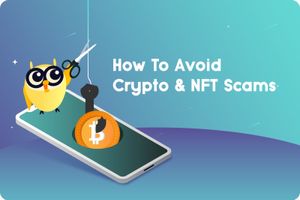As the popularity of cryptocurrencies and non-fungible tokens (NFTs) continues to grow, so do the opportunities for scammers to take advantage of unsuspecting investors. While the decentralized nature of blockchain technology provides a high level of security, it's important to remain vigilant and educate yourself about the potential risks involved in the cryptocurrency and NFT space.
👀 In this article, we'll go over some tips and best practices for avoiding scams and protecting your investments.
🔍 DO YOUR OWN RESEARCH (D.Y.O.R.)
📚An effective way to avoid scams is to simply do your own research (often abbreviated to D.Y.O.R.) before making any investments. This includes researching the team behind a potential investment project, understanding the technology behind it, and looking for reviews or articles from trusted sources.
💰Although less common these days, Initial Coin Offerings, or ICOs, were a regular occurrence in the crypto arena where many new coins and tokens launched onto markets. For ICOs, it's important to read the whitepaper📄 and get a clear understanding of the project's goals, roadmap, and use case. If the whitepaper is lacking in detail or doesn't make sense, it may not be legitimate.
💫When it comes to NFTs, it's important to verify the ownership and provenance of the asset.This means verifying that the person or entity selling the NFT is actually the owner of the asset and has the right to sell it.
🌐One way to verify an NFT is through the use of blockchain explorers. These are tools that allows users to view and examine the details of transactions on a blockchain. By using a blockchain explorer, the entire transaction history of a specific NFT, including any past ownership or transfer of the asset can be viewed. This can help to verify that the NFT is genuine and has a legitimate ownership history.
🏪Other tools, such as NFT marketplaces or platforms, may also have features that allow NFT verification. These may include features such as verified ownership, provenance documentation, or even physical authentication of the asset.
🚨🚩 RECOGNIZE THE RED FLAGS
🚫💰A common cryptocurrency scam is the "fake ICO”, whereby scammers create a fake coin launch and solicit investments from unsuspecting individuals. These scams often have a number of red flags that identify them:
- 📧Unsolicited emails or social media messages for promotion
- 👥A lack of transparency about the team behind the project
- 📈Vague or unrealistic promises of high returns on investment
- 📄Lack of a whitepaper or other detailed information about the project
If encountering an ICO that exhibits any of these red flags, it's best to stay away and do some more research before making any investments.
🚫🖼️Another type of scam to watch out for is the "fake NFT". These are created by scammers in order to deceive investors. Various types of NFT scams include:
- 🌫️Rug pulls – developers hype up an NFT project for invesment money and then cancel the project shortly after launch, keeping the funds raised for themselves.
- 🪂Airdrop/Giveaway scams – NFT giveaways are offered on social media to promote a project. Users sign up on a website but fraudsters will request crypto wallet information (privte keys and seed codes) to access the wallet’s assets.
- 📉Pump & Dump scams – large amounts of crypto are purchased by a group to drive up an asset price. The scammer dumps the assets and cashes out, leaving others with losses.
- 👁️Counterfeit/Plagiarized NFTs – NFT artwork is copied and sold on reputable NFT marketplaces and sold at high market prices despite being of no value.
Some ways to identify a fake NFT include:
- 👤Unverified or anonymous creators
- 👨🎤Impersonators imitating a celebrity profile
- 📜Lack of verifiable ownership or provenance
- 💲Overly hyped or unrealistic prices
If an NFT seems too good to be true, do the due diligence and verify the authenticity of the NFT before making any investments.
🔒 PROTECT YOUR ACCOUNTS & PERSONAL INFORMATION
🕵️It's also important to take steps to protect your accounts and personal information. This includes using strong, unique passwords for your accounts and enabling two-factor authentication (2FA) whenever possible.
🎣Phishing attacks are a common tactic used by scammers to gain access to users' accounts and steal their assets. To avoid falling victim to phishing, it's important to be vigilant and to double-check the URL of any website links clicked on, as well as being wary of suspicious emails or messages🕵️♀️.
💰 USE TRUSTED EXCHANGES AND WALLETS
😇Finally, it's important to only use trusted exchanges and wallets (both hardware wallets and software wallets) to store and trade cryptocurrency and NFTs. Some ways to identify a trusted exchange or wallet include:
- ✔️A long track record of security and reliability
- ✔️A large user base and positive reviews
- ✔️Support for multiple security measures, such as 2FA and cold storage
By using trusted exchanges and wallets, the risk of assets being stolen or lost is greatly reduced. It's also a good idea to diversify your portfolio and not keep all assets in a single exchange or wallet.
👉Cryptocurrencies and NFTs can be great investments, but it's important to be aware of the potential risks involved. Following the above tips wil ensure scam protection and investment security, assist in navigating the cryptocurrency and NFT space with confidence and help to provide informed investment decisions.
The information provided on this website does not constitute investment advice, financial advice, trading advice, or any other sort of advice and you should not treat any of the website's content as such. Bloom does not recommend that any cryptocurrency or NFTs should be bought, sold, or held by you. Do conduct your own due diligence and consult your financial advisor before making any investment decisions.
